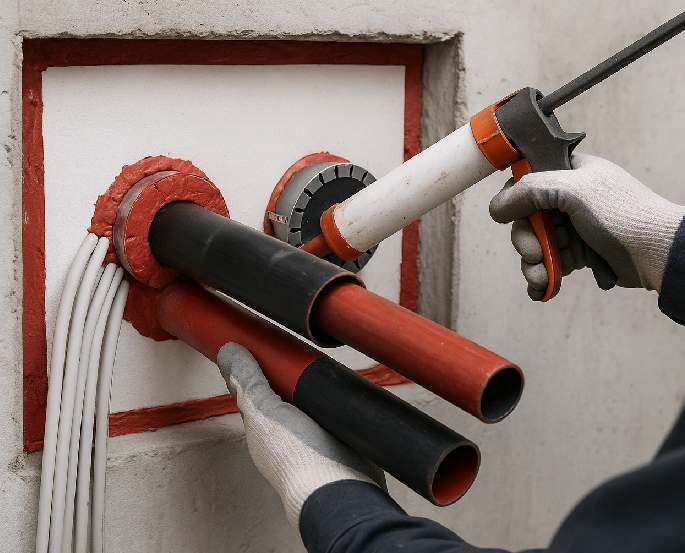


All structural components required to save human life have a fire resistance rating. This indicates how long walls or ceilings will continue to function in the event of a fire. If media such as cables or pipes penetrate these components, these openings must be closed for fire protection. The expert speaks of cable, pipe or combination seals.

Due to the increasing complexity of technical building equipment, choosing the right sealing system is not always easy. Not only the different pipe and cable systems, but also the installation distances and component thicknesses make it difficult to select a fire barrier that complies with the approval.
For pipe seals, the Model Building Regulation stipulates that pipelines may only be passed through space-enclosing components with the prescribed fire resistance if the fire has not spread for a sufficiently long time or if precautions have been taken.
As a precaution, pipe seals are used that either have the same fire resistance as the room-enclosing components or go beyond that. They must be made of non-combustible building materials. More details are specified in the German "Muster-Leitungsanlagen-Richtlinie" (MLAR) (model pipe system guidelines).
The regulations for buildings in building classes 1 and 2 or within flats and within the same utilisation unit with up to 400 m² on up to two floors are less strict. There is also relaxation for individual electrical lines, more precisely specified pipelines made of selected, non-flammable building materials up to 160 mm outside diameter and installation pipes for electrical lines up to 32 mm outside diameter made of flammable building materials, aluminium or glass.
Pipe seals are primarily required for pipes that can burn or melt, such as plastic pipes. Although the fire can spread further inside the pipe, further spread is prevented at the openings, for example by means of fire protective collars as fire-retarding sealings. Both pipe and cable seals are divided into fire resistance classes that provide information about the fire resistance duration in minutes.
For the closure of cable or line openings with metallic conductors or for busbars or optical fibres in components, cable penetration seals are required. For the installation of cable seals, the occupancy density as well as the necessary distances to the surrounding components must be observed. It is also important to create the cable seals in such a way that it is easy to change the occupancy density later. To do this, add a reserve area of 40% for subsequent allocations.
In the case of cable penetration seals in particular, the optimal solution for a specific application must be found from many design options. As experts in sealings, we would be happy to make this selection.
Not only the sealing measures, but also their documentation is mandatory. For this purpose, we will hand over a declaration of conformity in the form of a general technical approval (abZ) to the site management of your company. In it we declare that the cable seals meet the requirements of the approval. Building contractors need this declaration for the acceptance according to the contracting rules for award of public works contracts. We also mark the sealing with a sign on which all necessary information is noted.
Brandschutz Service Berlin is your experienced specialist for the professional installation of cable penetration seals in Berlin and the surrounding areas. We ensure that all installations meet the highest safety standards and current regulatory requirements.
We are your reliable partner for pipe penetration sealing in Berlin, Brandenburg, and throughout Germany. Our team specializes in the fire-safe installation of all types of pipe penetrations and provides comprehensive advice on the best solutions for your project.
Brandschutz Service Berlin professionally installs combination fire protection penetration seals in Brandenburg and beyond. We find the optimal solution for complex penetrations where both cables and pipes require fire-resistant sealing.
For new construction projects in Berlin, we offer comprehensive services in the field of fire protection penetration sealing. From planning to installation, we ensure that all fire protection requirements are correctly implemented from the very beginning, keeping your construction project safe and compliant.
Brandschutz Service Berlin also specializes in the refurbishment and retrofitting of existing fire protection penetration seals in older buildings. We assess the condition of your current seals and update them to meet the latest standards and regulatory requirements.